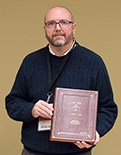
PREV ARTICLE
NEXT ARTICLE
FULL ISSUE
PREV FULL ISSUE
DAVID FANNING ON THE NUMISMATIC LITERATURE MARKETOn Friday, October 31, 2014 Charles Morgan of CoinWeek published a report
on the previous day's events at the Whitman Baltimore Winter coin show. In it, he interviews
David Fanning of Kolbe & Fanning Numismatic Booksellers about the current state of the
numismatic literature market. Here's an excerpt. -Editor
When I caught up with them, they were sitting in a room on the third floor, holding a lot viewing for their Saturday sale. On display were hundreds of books, including many great rarities. A collector of numismatic literature myself, I found many offerings to be of particular interest. But, I wondered: What makes the numismatic literature market in the United States tick? “It’s a three-part market for us,” Fanning explained. “Ancients, which [are] always strong, Medieval and Modern Foreign, and U.S. The U.S. literature market is getting hot right now. “Most of the lots here are U.S.,” he continued, picking up an attractive volume bound in full morocco entitled The Early Coins of America by Sylvester S. Crosby. “This first edition Crosby catalog has a complicated publication history. It has the original 1873 title page and intro plus the 1875 title page. In addition, it has a rare Edward Maris Woodburytype Plate, Plate XI, which is found in perhaps one out of every 10 copies we see. Also, the piece has a handwritten key to the plate, written by Maris, and a handwritten review of the auction, also by Maris. “We can’t say for sure, but based on this and other evidence, we believe that this might have been Maris’ personal copy. This catalog was bound, probably in the early 1980s by Alan Grace for Armand Champa. It sold in 1994 to a collector, who recently sold it to us.” “You don’t really see the use of plates much anymore,” I said, and the two partners tried to think back to the last time that they had seen an auction house produce them with any regularity. Kolbe thought one might have to go back to old Superior catalogs to find ones of a more recent vintage. Despite their disappearance, collectors still find the inclusion of plates in older catalogs beneficial. “It’s about determining provenance,” said Fanning. “For an ancient coin collector, someone with a high-end coin–maybe a $25,000 or a $250,000 ancient coin–numismatic plates are essential. [They’re] essential because, for many of these great rarities, you have to be able to show provenance, for protection. Otherwise, some government might say that you dug it up out of the ground last week and try to seize it from you. If you can show that the exact coin was sold before and here’s a plate of it from a 1904 catalog, then you are good to go.” To read the complete article, see:
Wayne Homren, Editor The Numismatic Bibliomania Society is a non-profit organization promoting numismatic literature. See our web site at coinbooks.org. To submit items for publication in The E-Sylum, write to the Editor at this address: whomren@gmail.com To subscribe go to: https://my.binhost.com/lists/listinfo/esylum All Rights Reserved. NBS Home Page Contact the NBS webmaster 
|
